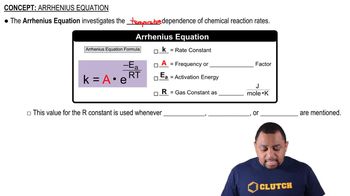Here are the essential concepts you must grasp in order to answer the question correctly.
Arrhenius Equation
The Arrhenius equation relates the rate constant (k) of a chemical reaction to the temperature (T) and activation energy (Ea). It is expressed as k = A * e^(-Ea/(RT)), where A is the pre-exponential factor, R is the universal gas constant, and T is the temperature in Kelvin. This equation highlights how temperature influences reaction rates and is fundamental for calculating Ea and A.
Recommended video:
Activation Energy (Ea)
Activation energy (Ea) is the minimum energy required for a chemical reaction to occur. It represents the energy barrier that reactants must overcome to form products. A higher Ea indicates a slower reaction rate at a given temperature, while a lower Ea suggests a faster reaction. Understanding Ea is crucial for predicting how temperature changes affect reaction rates.
Recommended video:
Pre-exponential Factor (A)
The pre-exponential factor (A) in the Arrhenius equation is a constant that represents the frequency of collisions and the orientation of reactants during a reaction. It reflects the likelihood that collisions will lead to a successful reaction. A is temperature-dependent and can be determined alongside Ea when analyzing the temperature dependence of rate constants.
Recommended video:
 Verified step by step guidance
Verified step by step guidance


